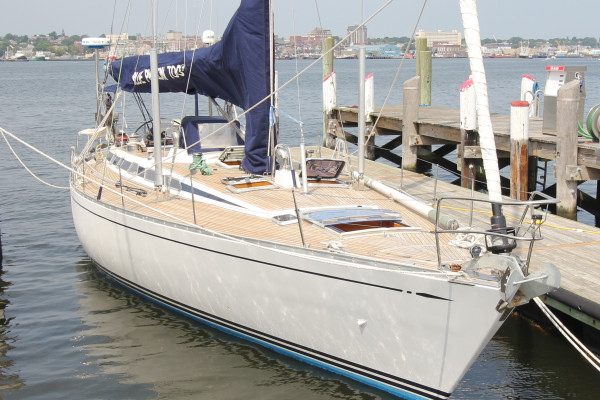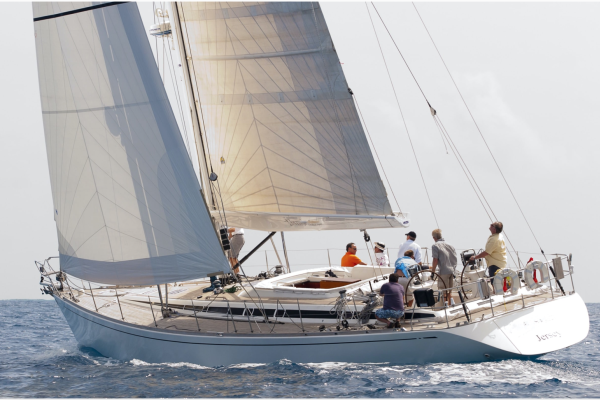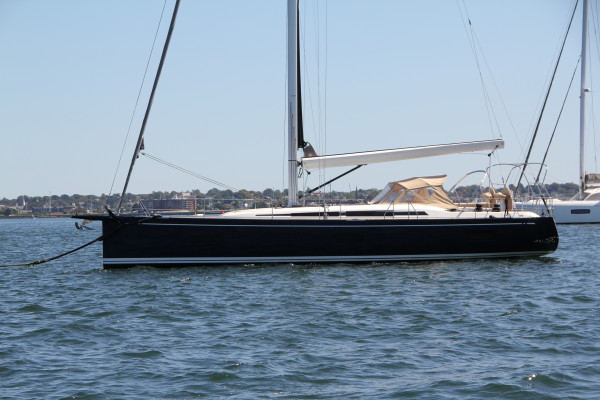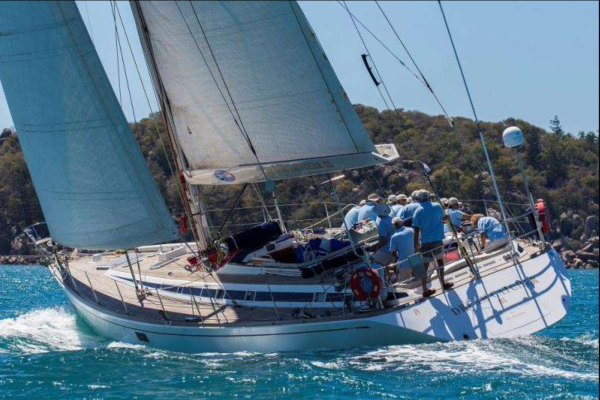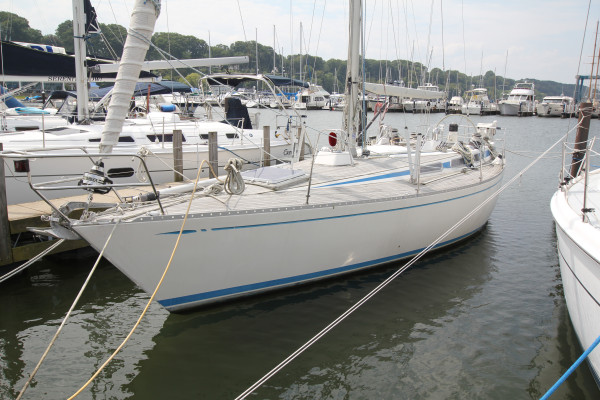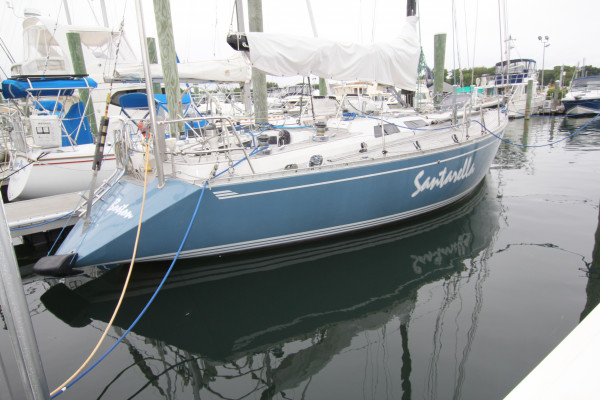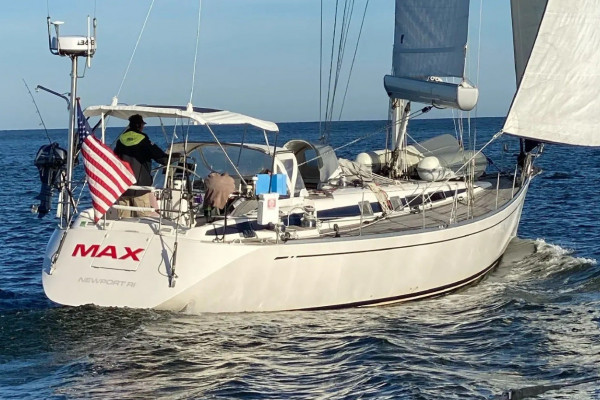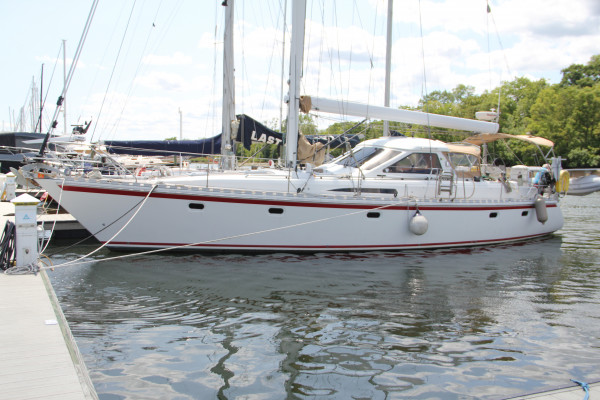Sold - Swan 80 FD CHESSIE
Carbon hull, carbon deck and high modulus carbon spars together with high tech standing rigging. Nothing short of spectacular! CHESSIE benefits from having an external project management team that looked at every detail before building was allowed to start.
CHESSIE was built with performance sailing in mind, without compromising the comfort Swans are notorious for. To accomplish this the deck plan was customized to keep the hardware as light as practical, the rig was built with high modulus carbon and the standing rigging is high tech PBO and carbon.
This Swan 80 is the last one built, to date. Her keel has been modified to maximize performance while keeping shallower water sailing in mind. The keel foot print allows for a deeper more performance oriented keel to be added if desired and if racing becomes more of the focus.
The vast majority of the sailing CHESSIE has completed to date is local cruising on the east coast of the US. She has raced on rare occasions winning her class and first home in the 2014 Fort Lauderdale to Palm Beach race.
CHESSIE is beautifully appointed with details such as light colored deck caulk to help keep the decks cool in hotter climates, additional hand holds on deck and below deck for added security. The interior furnishings were hand selected to give a light, practical and welcoming appearance.
They don't come any better than this. Highly recommended. You will not be disappointed. We look forward to receiving your inquiry.
{gallery}80.004.chessie.exterior{/gallery}
HULL
The layup uses carbon SPRINT/pre-preg.
All the stiffeners are epoxy with unidirectional carbon fiber reinforcements. The engine beds are integrated in the stiffeners.
The structural bulkheads are foam cored with carbon SPRINT/ pre-preg laminate. The core material is CorecellTM.
The composite chain plates are built using SPRINT/pre-preg unidirectional carbon fibre straps laid over stainless steel bushings.
Dark colored topsides, Night Blue, Du Pont polyurethane paint with clear coat on top.
Boot top and cove stripes, Du Pont Steel Grey Met.
The bottom is treated with two layers of gel shield epoxy primer. There are two layers of International Uni Pro.The bottom was painted with Seahawk BioCop TF in September, 2014.
The ballast bulb is lead casting with 4.5% antimony and is attached to a high strength steel keel fin. The keel is attached to the hull with AISI 329 bolts.
The steering system is a twin wheel sprocket and a chain system with JP3 Dyneema 8mm, 3.2 turns H.O. to H.O. The steering cables are independently connected to the quadrant.
It has carbon fibre/epoxy skins on a foam core, with a tubular carbon fibre stock. The lower tip of the rudder is designed to break before the stock does. A weed deflector is located in front of the rudder and is surface mounted.
The rudder is supported by two self-aligning bearings.
The steering pedestals are built in composite.
There are two 1200 mm clear coated 3-spoke carbon composite Nautor wheels. The wheels can be disengaged.
The rudder stock is provided with a fitting for the emergency tiller. The emergency tiller is stowed in the lazarette.
The mast is stepped through the deck onto a carbon fibre mast step.
There are two tie rods attached to the mast collar and the step.
Sea cocks in engine room are made in bronze. All other through-hull connections below waterline are made of composite.
The transom is "open".
A large transom hatch gives direct access to the aft storage. The transom hatch extends all the way up to deck level for maximum opening and a discrete look.
The transom hatch doubles as a bathing and boarding platform. It is made from carbon fiber pre-preg and has 9 mm teak recessed on the backside. The hatch is hydraulically operated.
There are six hull windows. Four in the saloon and two in the aft cabin. The windows are of tinted and toughened laminated safety glass.
The yacht is equipped with a 3.5 m foldable carbon fiber gangway which stored in the lazarette.
The carbon fiber boarding/bathing ladder allows boarding of the yacht from the side.
The carbon fiber bathing/boarding ladder is stored in the lazarette.
There are provisions for storage of the yacht’s equipment in the lazarette.
There is space in the lazarette to store a 3.3 m (11 ft) inflatable dinghy. There is a hydraulics winch for hauling the dinghy.
Stainless steel rod in lazarette to stow running rigging.
DECK
Deck layout was customized from the standard spec to maximize weight saving. Titanium replaced stainless steel for numerous fittings and all of the blocks are using Blew Stoub custom soft shackles and lash tangs.
The main deck is of a carbon fiber SPRINT/pre-preg sandwich construction with Nomex honeycomb core. Coachroof and coamings are of a carbon fiber SPRINT/pre-preg sandwich construction with CorecellTM core. High density core is located in way of deck fittings.
All visible composite surfaces are painted using DuPont polyurethane paint system, color snow white M1010.
The teak deck consists of 65 x 9 mm teak battens with grey 5 mm caulking. The teak deck is vacuum bonded with epoxy. There are two angled platforms at the steering consoles.
All winches are hydraulically driven from the onboard hydraulic system.
Two primary sheet winches Harken B1111.3 STCAC-HY three speed, with carbon skirt and top, aluminium drum
Two secondary sheet winches Harken B1111.3 STCAC-HY three speed, with carbon skirt and top, aluminium drum
Two Harken B990.3 STAAC-HY three speed Halyard winches, with aluminium drum and base, carbon top
One additional halyard winch Harken B990.3 STAAC-HY, hydraulic, 3 speed, aluminum drum and base with carbon top, including additional power pack function
Free spinning bases for Harken primary and secondary winches.
The Lewmar V6 hydraulic windlass is installed in the anchor locker. The windlass is controlled by wired remote control.
One hydraulically operated, pivoting anodized aluminium arm for stowing the bow anchor in the anchor locker.
Main sheet track with car, end stops and blocks, including hydraulically powered main sheet traveler system.
Barber hauler system with hydraulic cylinder on mast, including deck fittings and lines.
Preparation for bow sprit including: reinforcement for the bobstay, bobstay fitting.
Spinlock jammers at mast area for halyards.
Titanium bow and stern rails 750mm high.
1 x 19 stainless steel wire double lifelines.
Titanium stanchions.
Titanium pop up mooring cleats, 4 pair.
Titanium pop up fairleads, 2 pair.
Titanium removable toe rail along centerline on the foredeck.
Titanium Wichard folding pad eyes.
Other stainless steel deck fittings glass pearl sanded to look like titanium.
10 x opening deck hatches.
4 x teak covered hatches.
2 x pair flush mounted tinted acrylic fixed ports on each side of the coaming over the saloon.
Optional larger portholes, 4 each.
Additional porthole in port side amidships cabin.
There is a lockable manually operated sliding companionway hatch of tinted acrylic and a manually operated drop board.
There is a large forward cockpit providing comfort both under sail and at anchor. The aft cockpit has ample space for relaxing and sunbathing.
There is a seat with backrest on each side of the forward cockpit.
Teak cockpit table with carbon edge trim.
Winch covers.
Padded hull protection for bow when boat is at anchor, Sunbrella navy blue.
Spray hood over companionway entrance folds forward and stows flush with deck.
Cockpit cushions with back rests.
Sun awning.
Padded cover for cockpit table.
Canvas covers for wheels and pedestals.
Main sail cover.
Cover for companionway stairs and handrails.
Cup holders at each pedestal.
Additional handrails positioned at the steering pedestals, on the coachroof forward of the sea hood, at main companionway and on aft deck.
Additional teak foot supports.
Helmsman supports in titanium aft of pedestals.
{gallery}80.004.chessie.deck{/gallery}
INTERIOR
GENERAL ARRANGEMENT
Sleeps 8 guests in 3 guest cabins plus 2 crew in the forward crew cabin and 1 in the pullman cabin for a total of 11. See Interior Plan.
Varnished hand rubbed teak on most of the joinery work below deck. The floorboards are of foam cored construction. The top face is teak and koto wood (width 90/4 mm). The floorboards are oil-waxed and have the same satin finish as the rest of the interior. Four suction lifters are provided.. Vinyl clad overhead panels are installed in all accommodation areas.
The topsides, where visible, are covered with vinyl panels.
Hardware and outfit components are of a type designed to eliminate rattling or banging. The cabin doors are provided with double action locks and with catches to hold them in open position where possible.
All bathroom doors can be locked with a knob and from the inside
All locker doors are fitted with high quality furnishing hinges and are kept closed with push to open-latches. Door stoppers are fitted where needed. The hanging locker internal light will automatically switch on when the door is opened.
All openable deck hatches and coaming windows are fitted with manual roller blinds and mosquito screens. Hull windows are fitted with manually operated wooden venetian blinds.
The deckhouse windows are fitted with manually operated blinds.
Heated mirrors in each head.
Additional hand holds throughout the interior.
FORWARD CREW CABIN
The forward cabin features an upper and lower berth on starboard side and a three person settee and a Pullman berth on port side. Two hanging lockers are placed at forward end of the cabin. A fold-up table is in the middle of the cabin.
There is a large hatch with a ladder for entrance from deck and access to galley is in the aft end of the cabin. A bathroom is in the forward end of the cabin.
GALLEY
The galley is located on the port side of the yacht forward of the saloon. The under mounted sink, dishwasher and the washer/dryer are located in a center line locker. The gimballed gas stove, fan, microwave oven and a fridge are located outboard. A second fridge and the freezer are located forward against the crew cabin bulkhead. There are lockers and drawers for storage.
All the appliances have a stainless steel finish.
Total of four refrigeration units.
Two front loading refrigerators with a total volume of 320 l
Front loading freezer with a volume of 130 l
Frigonautica refrigeration is a combination freezer/fridge and located under the floor boards in the galley. Four burner gas stove with an electric oven
Cooker hood
Microwave oven
Dishwasher
Washer/ Dryer
FORWARD STARBOARD GUEST CABIN
The cabin features a double bed outboard. There is a combined bookshelf-locker aft above the berth and a Pullman berth outboard. Clad headboard and bed side panel.
A hanging locker is located outboard at forward end of the cabin. En-suite head with stall shower forward end of cabin.
SALOON
The saloon features an open, voluminous arrangement.
Dining for eight persons is provided on port side consisting of a dining table, settee and five loose chairs. A lounge area with generous, relaxed settee and a coffee table with space for storage is located on starboard side.
NAVIGATION STATION
The navigation area is located aft of the saloon on starboard side facing outboard.
PORT MIDSHIP GUEST CABIN
The cabin features a wide single bed outboard. There is a Pullman berth outboard. Clad headboard and bed side panel.
A hanging locker is located outboard at aft end of the cabin. Ensuite head with stall shower at aft end of the cabin.
STARBOARD PULLMAN CABIN
Located aft of the navigation station in the walkway to the aft master cabin. Drop down pullman bunk. Cabin doubles as an enclosed office space. Lockers outboard.
MASTER CABIN AFT
The cabin features a large double berth in the center of the cabin.
There is a settee and night stand either side of the bed. Bookshelves are at aft bulkhead and hanging lockers outboard on both sides in the forward end of the cabin. Ensuite head with stall shower located at forward and starboard of master cabin.
{gallery}80.004.chessie.interior{/gallery}
ENGINE & HYDRAULICS
ENGINE
The marine engine, a Steyr MO196 K35, is a modern lightweight 6 cylinder in-line diesel engine displacing 3,2 liter and delivering 190 bhp (140 kW) at 3500 rpm. Start stop button in engine room.
GEARBOX
There is a direct mounted ZF 45-1 reduction gear with a ratio of 3,741:1 installed on the engine.
The Aquadrive B30 thrust bearing and the CV32 coupling allow the soft mounts on the engine and reduction gear to be optimized for quiet and vibration free running.
PROPULSION
The propeller shaft is made of corrosive resistant steel with a diameter of 50.8 mm. The shaft is supported by water-lubricated rubber bearings at the propeller bracket and stern tube.
The propeller is a folding 4-blade ø30”x23” Bruntons Varifold.
COOLING SYSTEM
There are thermostatically controlled fresh water cooling systems with sea water heat exchangers, for both engine and the generator. There is a combined seawater intake for both the main engine and the diesel generator which is equipped with a seacock and a strainer. The cooling water is discharged through individual exhaust water separators and seacocks for the main engine and diesel generator respectively.
FUEL SYSTEM
The feed lines to the main engine and diesel generator are equipped with 10 Separ fuel filters/water separators. There is a single version fuel filter installed for the diesel generator and a dual version for the main engine. The dual version permits uninterrupted running of the main engine while changing filter elements. Both filter versions are equipped with a water-in-fuel alarm. All flexible hoses are according to ISO 7840 standard.
The four fuel tanks are built in stainless steel. The total fuel capacity is 1500 l (396 US gal). The tanks have individual level indicators. There is a separate filler line for port and starboard side. The tanks are equipped with hatches of adequate size to allow inspection and cleaning. All tanks are pressure tested to 0.45 bars. Shut off valves are provided for each tank.
EXHAUST SYSTEM
The exhaust gases are discharged through a wet exhaust system. The silencers and gas/water separators are in composite. They are installed on soft mounts for both the main engine and the diesel generator. Water is discharged below the waterline and exhaust gases exit under the transom well above the waterline. All silencers are provided with a drain tap.
OIL HANDLING SYSTEM
There is a drip tray installed under the main engine and diesel generator. The electric oil drain pump, the Reverso OP 703, is installed for the draining of the diesel generator and main engine oil pans and their drip trays.
THRUSTER
The bow thruster is a MaxPower 300/15. The thruster is powered by a hydraulic PTO on the diesel generator.
FIRE FIGHTING SYSTEM
A total flooding Clean Agent fire extinguishing and alarm system is installed in the engine room spaces with a manual remote control located on the port side in the cockpit coaming.
HYDRAULICS
The hydraulic system consists of a central power pack supplying regionally located valve groups, thereby achieving maximum power to weight ratio.
Each control valve group is situated close to the operating unit, giving a precise control and allowing for a quiet and smooth operation, eliminating inherent hydraulic noise and vibration.
Each control valve group can be isolated from the hydraulic main line by manual shut off valves allowing the use of other functions while maintaining one valve group.
HYDRAULIC FUNCTIONS and POSITIONING
Hydraulic KILL-switches, located on port and starboard pedestals as well as the engine room
Quick release, on port pedestal
Windlass, on wandering lead (handheld control)
Anchor arm, on wandering lead (handheld control)
Jib furler, on starboard & port cockpit panels
Jib furler length adjuster, on button in sail locker
Inner forestay tensioner, on forward starboard cockpit panel
Jib car puller PORT, on port cockpit panel
Jib car puller STBD, on starboard cockpit panel
Bow thrusters up/down, on engine control panel
Bow thruster (to PORT / to STBD), on foot switches under starboard side pedestal
Halyard winch PORT, on foot switches close to the winch
Halyard winch STBD, on foot switches close to the winch
Boom vang, on port pedestal
Main outhaul, on port pedestal
Jib halyard tensioner, on forward starboard & port cockpit panel
Cunningham, control on port pedestal
Primary winch PORT, on foot switches close to the winch
Primary winch STBD, on foot switches close to the winch
Secondary winch PORT, on foot switches close to the winch
Secondary winch STBD, on foot switches close to the winch
Main sheet captive winch, on both starboard & port pedestal
Transom hatch, on wandering lead (handheld control)
Backstay tensioners, on port pedestal
Dinghy winch, on wandering lead (handheld control)
POWER PACK
The power pack is equipped with two electric pump units as well as one pump unit mounted on the diesel generator power take off. The power pack is also equipped with a return filter, oil level sensor, temperature sensor and an air breather. A separate electric pump, Reverso GP-302, is installed inside the engine room for filling of the hydraulic power pack.
PNEUMATICS
The yacht is equipped with a low pressure compressed air system. The system is mainly intended to inflate the transom door sealing. There is also a quick connector in the lazarette for low pressure air tools.
ELECTRICAL
GENERAL
The AC system is a 230 V 50 Hz single-phase three-wire system. The 230 V can be powered by the diesel generator or by shore connection. There are also a number of 230 V 50 Hz appliances powered by a DC/AC inverter.
SHORE POWER
The shore power inlet is 230 V 1-phase 50 A. There is also an additional shore inlet 230 V 1-phase 50 A for air conditioning. The two shore power cables are 15 m long. Inlet connectors are located in coaming.
FREQUENCY CONVERTER
ASEA 12kVA frequency converter connected to the 230V shore inlet. Location is in a cooled box. inside the starboard lazarette. Input 170V to 520V, 40Hz to 70Hz. Output, 230V 50Hz.
The cooling is provided by a Marine Air self contained unit, 6000BTU.
GENERATOR
There is one 20 kW Northern Light diesel generator producing single-phase 230 V 50 Hz AC. The unit is mounted on elastic seatings. The generator is mounted inside a sound shield. Maximum permissible heel angle is 23° port and starboard and intermittent 35°, up to two minutes.
CHARGERS
There are three Mastervolt ChargeMaster 24 V 100 A chargers with 3-step charge characteristics for the service battery. Temperature measurement in service battery box is shown on bus display at chart table. There are two Mastervolt Magic 24/24V 16 A DC/DC converters charging the handling system battery from the service battery bank.
INVERTER
There is one Mastervolt Mass Sine 24/2500 inverter, that converts 24 V DC to 230 V AC 50 Hz 2500 VA for single-phase AC consumers.
There are 13 115V sockets throughout the boat powered by a 115V 60Hz Mastervolt Mass 24/2500 inverter, capacity2.5kVA.
OUTLETS AC
There are 230 V outlets of schuko type. One single outlet per bathroom, one double outlet per cabin, two double outlets in crew area, two double outlets in galley, two double outlets in saloon, one in single outlet in engine room, one single outlet in port side lazarette, one single outlet in sail locker and a double outlet at the chart table.
EARTHING SYSTEM
The AC system is using a grounding plate as an underwater earthing point. The plates is located aft of the propeller bracket.
LIGHTNING PROTECTION
The mast and the shrouds are electrically connected to the keel. In the top of the mast there is an air terminal connected to a lightning conductor which runs down to the keel.
GALVANIC PROTECTION
The propeller shaft, the keel and bow thruster have their own individual sacrificial anodes.
DC SYSTEM
The DC-system is based on Multiplexing CAN Technology. The CAN-technology allows distributed switching and protection of electrical loads.
The functions can be controlled and monitored on a touch screen located in the forward end of the galley.
It includes alarm functions which can be displayed on the same touch screen. The important functions have a manual override.
The DC system is 2-pole 24 V, with an insulated return, mainly used for lighting, fans and pumps. The wires are sized to minimise voltage drop.
SERVICE BATTERIES
Lithium batteries. Service battery 1120Ah/1h (equal to 1490Ah gel). Handling system battery 320Ah/1h (equal to 420Ah gel).
ALTERNATOR
There is a 28 V 140 A Iskra flywheel alternator on the main engine. The alternator is charging the service battery bank.
OUTLETS DC
There are five 12/24V DC Aqua Signal outlets, one in the side of the lazarette, one in the engine room, one in the anchor locker, one on the mast and one in aft cockpit. There is a 12V outlet at navigation table of cigarette lighter model.
WATER METERING
Water tank levels are displayed on the touch screen. The tank level sensors are made by VDO.
FUEL METERING
The fuel tanks levels are displayed on the touch screen. The tank level sensors are made by VDO.
MONITORING
The following alarms / readings are displayed on the touch screen including an audio signal at the helm:
Bilge levels high
Black water tank levels high
Black water tank levels full
Grey water tank levels high
Grey water tank levels full
Water pressure pumps run dry
Deck wash pump run dry
Water in fuel separators
Hydraulic general alarm
Low battery voltage, service battery bank
Low battery voltage, handling system battery bank
Navigation light failure (side, stern and motoring lights)
LPG leakage
Generator overload
Engine room temperature reading and high alarm
Service battery box temperature reading and high alarm
Level metering:
Ah metering
Water tanks
Fuel tanks
Grey water tanks
Black water tanks
There is a separate display for the hydraulic plc control, located inside of the cabinet opposite to navigation table:
Low oil alarm
Temperature alarm
Oil pressure in bar
FIRE ALARM
There is a separate fire alarm temperature sensor in the engine room that stops engine room ventilation and closes its ventilation fire dampers.
ENGINE and GENERATOR DC
STARTING BATTERIES
There are two Optima Yellow Top DC 5.5 12 V 75 Ah batteries, one for the main engine and one for the generator.
The starting batteries are of maintenance free AGM type batteries and located outside under the floor in a ventilated box fwd of the engine room.
STARTING BACKUP
There is a paralleling button, on the engine control panel on starboard side in cockpit, for paralleling of the main engine and generator starting batteries.
OTHER
There is a 12 V 90 A alternator on the main engine for charging engine starting battery.
There is a 12 V 40 A alternator on the diesel generator for charging the diesel generator starting battery.
AC and DC PANELS
There is a touch screen at the navigation table for operation of the electrical system.
DOMESTIC APPLIANCES
Dishwasher, Miele G1272 SCVi 230 V 2.3 kW
Microwave, Miele M 8161-1 1.3 kW
Washer and Dryer, Miele WT 2670 WPM 230 V
Refrigerators, Two Frigonautica 160 l 24 V DC refrigerators in galley.
Freezer, One Frigonautica 130 l 24 V DC freezer in galley.
Stove and Oven, Four burner gas stove Miele CS 1034 G (30mbar) with an electric oven Miele H 5040 B 3.2 kW.
Ceramic hob, 2 plates, Miele KM 418.
Icemaker, Raritan 85B505-2, 230V, installed inside coffe table.
Waste disposal unit, 55 in-sink-erator.
LIGHTS
OVERHEAD LIGHTS
Indirect LED lights are of Frensch LED sticks and as down lights Frensch F-19. There are dimmer controls in owners-, guest cabins and in the saloon and LED lights in engine room. Other areas have Frensch F-16 LED lights
READING and TABLE LIGHT
There is one Meljac L115901H reading lamp with an integrated on/off switch for each fixed bed in the crew and guest cabins. In aft cabin two table lamps as reading lights.
LOCKER LIGHTS
There are Frensch automatic LED lights in all hanging lockers.
INDIRECT and COURTESY LIGHTS
Owners Cabin
LED ligt in base of forward end of bed
Saloon
LED light in base of sofas
One Meljac LED reading lights on each sofa
NAVIGATION LIGHTS ON DECK
Stern light LED Lopolight
Port side light LED Lopolight
Starboard side light LED Lopolight
There is a second, back up set of navigation lights on a separate circuit.
All navigation lights are controlled from the cockpit, port coaming panel.
NAVIGATION LIGHTS ON MAST
The mast steaming light is a LED model controlled from the cockpit, port coaming panel.
The mast anchor light is a LED 360° model controlled from the cockpit, port coaming panel.
SPREADER LIGHTS
There are four spreader lights on the lower pair of spreaders facing down. Two of them facing forward and two of them facing aft. Controlled from the cockpit, port coaming panel.
WINDEX LIGHT
The Windex light at top of mast is controlled from the cockpit, port coaming panel.
BOOM LIGHTS
There are three boom lights. They are dimmer controlled as one group from the cockpit, port coaming panel.
PLUMBING & VENTILATION
GENERAL
A pressurised hot and cold water system is installed. The fresh water piping is mainly of polypropylene and nylon tubing.
One filler line on port side deck is led to the valve chest which has valves for each water tank and the pressure water pumps.
Hot and cold water is distributed to all heads, to the galley and to deck shower. Cold water deck wash connections are located one forward and one aft. One deck shower is installed at the bathing platform.
WATER TANKS
There are four polyethylene water tanks with a total capacity of 1200 l. The tanks are provided with baffles, hatches, level indicators and vent pipes. All tanks are pressure tested to 0.2 bars. Tank levels are shown on the electrical main touch screen.
PRESSURE WATER SYSTEM
The pressure water system has two Gianneschi ECOJET 24 V DC pumps. One 18 l pressure vessel is connected to the cold water system. Fresh water deck outlets at bow and stern.
HOT WATER SYSTEM
There is one 100 l stainless steel water heater installed. Hot water can be heated either by engine cooling water or with an electrical heating element. The inlet has a check valve to prevent hot water back flow. The outlet has a relief valve for over-pressure protection. There is a thermostat mixing valve installed on the water heater that controls the hot water temperature. One 18 l pressure vessel is connected on the hot water system side.
Quooker water boiler fitted in galley.
WATER MAKER
The water maker is a Sea Recovery Aqua Whisper 1400-2, 230 V AC with a capacity of 221 l / h. Both the low and high pressure pumps are located in the engine room for silent operation. The water maker is provided with dual pre-filters, the primary with a 25 micron cartridge, the secondary with a 5 micron cartridge.
The system is installed with fresh water flush and there is a remote control installed at the navigation table.
SEA WATER SYSTEM
The sea cocks in the engine room are in bronze and from Conbraco . All other through-hull connections below waterline are in Marelon, a glass reinforced plastic material (nylon) seacock from Forespar. The inboard side of the sea cocks are fitted with a stud long enough to take two hose clamps.
DECK WASH PUMP
There is an electrical deck wash pump, Gianneschi CB 25/16 24V DC capacity 160 l / min.
SEA WATER OUTLET
There is one sea water outlet in the forepeak locker and one in the lazarette.
GREY WATER SYSTEM
The grey water from wash basins, showers, condensing water from air conditioning and freezers/fridges is collected into the grey water tanks, if necessary by transfer pumps.
TANKS
Two polyethylene grey water tanks are provided, one forward and one aft, total capacity 270 l. Level switches are fitted to each tank, indication for ¾ full and full. The tanks are ventilated overboard and fitted with inspection lids.
TANK DISCHARGE SYSTEM
The grey water tanks are emptied by 24 V electrical pumps to sea cocks via siphon break loops. Manual back up pumps are also provided.
BLACK WATER SYSTEM
All toilets are connected to black water tanks. It is not possible to flush toilets directly over board.
TANKS
There are two polyethylene black water tanks, one forward and one aft, total capacity 270 l. Level switches are fitted to each tank with indication for ¾ full and full. The tanks are ventilated overboard and fitted with inspection lids.
TANK DISCHARGE SYSTEM
The black water tanks are emptied by 24 V DC electrical pumps to sea cocks via siphon break loops. Manual back up pumps and deck suction lines are also provided for each tank.
HEAD SYSTEM
The toilets are from the Tecma X-light carbon and operates on 24 V DC. They flush by means of a macerator pump using only 2.7 l fresh water per flush. The function cycle is completely automatic.
It is not possible to flush the toilet if the black water tank is full.
DRAINAGE SYSTEM
The bilges are kept dry by five automatically operated drain pumps, Whale Gulper 24 V DC. The bilge water is discharged through outlets above the waterline.
BILGE PUMP SYSTEM
There are four separate bilges: fore peak, accommodation area, engine room and lazarette bilge. Each bilge is equipped with a DC driven submersible pump, Gianneschi Maxisub. Two manual Whale Gusher pumps are installed as back-up pumps, one for the fore peak and accommodation area, the other one for the engine room and lazarette bilge.
Special attention is paid to ensure that bilge pump suction pipes are mounted in easily accessible positions to allow debris to be cleared.
INTERIOR DRAINS
The galley sink drains via a Y-valve either directly to a sea cock or to the nearest grey water tank. Condense water from the air-conditioning cabin blowers, discharge water from the shower trays and wash basins is also drained directly to the nearest grey water tank, if necessary by transfer pumps.
DECK DRAINS
Deck drains are connected mainly to outlets above waterline.
LPG SYSTEM
LPG is used for the cooker in the galley.
There is space for two 6 kg aluminium gas bottles in a drained locker with access from deck. A remote controlled magnetic shut off valve is installed in the gas bottle locker with a switch in the galley. There is a manual gas shut off valve at the cooker as well as an automatic gas detector / alarm in the galley. A manual leak detector is installed in the gas locker.
The gas installation complies with the ISO 10239 standard.
VENTILATION
The yacht has a forced ventilation system. Fresh air is led into the cabins and exhaust air out from the bathrooms. Both the supply and the exhaust systems have central fans. The speed of the fans is interlinked to each other. There is an adjusting valve on each connection for tuning the system. The fresh air inlet is equipped with a filter. Silencers are installed after the fans for silent running.
There is an exhaust hood over the galley.
ENGINE ROOM
The air inlets and the outlet are fitted with water traps and remote controlled fire dampers. The outlet fan is controlled by temperature.
Power supply to the fan is disconnected and the fire dampers are activated on fire extinguisher release.
BATTERY BOX
The battery boxes have forced ventilation with discharge through the mast tube.
CLIMATE CONTROL
A central waterborne cooling / heating system is installed for the entire accommodation. Condense water from the blowers is collected to the grey water tanks. The system is designed for operation in Mediterranean climate.
CABIN UNITS
The total cooling / heating capacity is divided in proportion to cabin volume and position. The system is designed for the air handlers to run on low speed for silent operation. There is an individual temperature control panel in each cabin. The blower speed control is stepless in automatic mode.
MAIN UNIT
There is a central chilled water system working on 230 V AC 50 Hz from shore power inlet or diesel generator. The main unit consists of 2 x MarineAir MCW 36 units with a total cooling capacity of 72.000 BTU / h (21.0 kW) and a total heating capacity in reverse cycle of 79.200 BTU / h (23.2 kW). The refrigerant used in the compressors is R407C.
There is a sea water cooled condenser with separate sea water pump.
REFRIGERATION SYSTEM
There are 3 Frigonautica Isotherm Compact Magnum 24 V DC water cooled compressor units for fridges and freezers.Additional freezer, 60ltrs, with dual thermostat that allows the freezer to be used as a fridge as well, located in galley under floor boards.
ELECTRONICS & NAVIGATION
COMPASSES
There are two Suunto F-135 magnetic steering compasses at helm stations.
A Brookes & Gatehouse Halcyon Gyro stabilized compass is used as the main heading source for the navigation instruments, autopilot and other instruments requiring accurate heading information.
CLOCK and BAROMETER
One Georg Jensen, Koppel clock. One Georg Jensen, Koppel barometer.
SAILING INSTRUMENTS
There is a comprehensive Brookes & Gatehouse H3000 Hercules Performance package with central processor unit, masthead unit, speed/temperature sensor and depth sensor.
There is one B&G mono-chrome Graphical Function Display located at navigation station and one additional at the helm.
Four 30/30 repeaters mounted on the mast on a carbon fibre bracket with reef line deflectors. The four 30/30 repeaters can be controlled from any GFD display.
GFDs also display hydraulic pressures for backstay, vang, outhaul, jib halyard, cunningham, inner forestay as well as forestay length adjuster position.
There are standard B&G depth and speed sensors with housing in plastic. There is a wind sensor at mast head, type vertical masthead unit
L=1450 mm.
B&G barometric pressure sensor.
B&G air temp sensor.
B&G audible alarm in sea cabin, crew cabin and cockpit.
Additional B&G H3000 Graphic at Function Displays at:
Nav station
Sea cabin
Crew cabin
Pedestals
Aft face of main sheet winch pod
Coaming forward of primary trimming positions
B&G H3000, 10/10 displays at:
aft cockpit, 2 pieces
pedestals, 2 pieces
Furuno audible alarm installed in sea cabin and crew cabin.
NAVIGATION SYSTEMS
GENERAL
A Furuno Navnet 3D black-box radar/chart plotting system comprising of processor unit MFDBB, control unit MCU-001 and 19 inch combined plotter/computer LCD screen Furuno MU-190HD positioned at the navigation station.
Each steering console is installed with one Multifunction display 12.1 inch, Furuno Navnet 3D MFD12.
The Furuno Navnet 3D software can be viewed in the saloon TV.
GPS
A Furuno GP-320B DGPS is used as the main navigator for:
Furuno NavNet 3D radar/chart plotting system
Brookes & Gatehouse
Brookes & Gatehouse autopilot system
GPS receiver, Simrad MX512 CDU with 5Hz DGPS smart antennaMX512A. Display at nav station. Antenna on stern rail.
Class B AIS transponder, Comar CBS200 including GPSand AST antenna splitter.
RADAR
The radar is a Furuno 4 kW 60 cm radome type antenna integrated with the Furuno NavNet 3D plotter system.
CHART SYSTEMS
The chart system for the Furuno NavNet 3D system is MapMedia 3D charts.
Navigation software, MaxSea Time Zero Explorer.
Jeppesen C-Map Mega Wide Area charts for MaxSea Time Zone and Furuno NavNet 3D.
Electronic charts for: North Sea, Baltic Sea, Western European coasts, Western Med, Mediterranean Sea, Black Sea, Atlantic Coast, Gulf of Mexico and Caribbean.
COMMUNICATION SYSTEMS
The Simrad RS-87H DSC VHF has two handsets, one at the navigation station and one at the helm station, with intercom possibility between the two. Additional Simrad AHK-87 handset in galley connected to Simrad RS-87.
There is a Sailor 150 FleetBroadBand satellite phone with handset installed at the navigation station. The FB250 system is connected to the computer for Internet and for sending/receiving e-mails.
The antenna is on the stern rail.
Yachtspot Internet WiFi system. Wireless base station. Apple Airport Extreme 5th generation installed in saloon ceilingfwd of hatch for optimum deck WiFi coverage.
Fixed wireless GSM/3G terminal at nav station.
ENTERTAINMENT SYSTEM
There is a Bose Lifestyle 48 DVD/CD/FM stereo system. The Bose System can store up to 300 hours of music on its hard drive. The unit is connected to the LCD TV.
iPod docking station, Apple universal dock. Connected to Bose stereo system.
Cockpit:
Four Poly-Planar MA-905 speakers are installed in the cockpit. Music is fed to the speakers as an individual zone from the saloon Bose system. The system is controlled by a Bose Personal Music Center II radio remote control as well as a volume control knob in cockpit.
Saloon:
LED TV 22", Samsung Series 5 with digital US ATSC tuner in crew cabin.
LED TV 32". Samsung Series 6 with digital US ATSC tuner in saloon.
I-Pod docking station.
Niles external IR sensor in saloon.
Radio/CD player, Yamaha, with B&W speakers, in forward midship guest cabin, aft port guest cabin and aft cabin.
Ethernet outlet in sea cabin connected to NavNet 3D network. Additional ethernet outlets in owner's cabin, nav station and sea cabin connected to GSM/GPRS/3G terminal as well as Fleet Braod Band sat com unit.
AUTO PILOT SYSTEM
There is a B&G H3000 ACP2 autopilot system with one GPD control unit at the helm.
There is an dedicated continuously running 24V Marsili/ Bosch Rexroth power pack powering the hydraulic cylinders.
The autopilot is driving the steering quadrant via twin Rexroth low friction cylinders.
ANTENNAS
The Furuno NavNet GP-320B DGPS antenna is mounted on the second port spreader.
The Furuno NavNet radar scanner (600 mm dome type) is mounted on the starboard spreader.
There is an R&R Electronic Delta Pacific 3G and Delta 2.4 WLAN active antenna at the masthead for the VHF, Navtex, TV and FM radio.
Emergency VHF antenna.
COMPUTER SYSTEM
The computer is a Dell OptiPlex 755 “Ultra small form factor” computer with a DVD station connected to the Furuno 19” LCD flat screen at the navigation station.
SECURITY SYSTEM
There is a Marco EW3 24 V foghorn.
RIGGING & SAILS
A Hall Spars three spreader fractional rig with discontinuous shrouds. The rig is set up for easy handling with swept back spreaders 21 degrees. The mast and the boom are clear coated.
The mast is a carbon fiber high modulus, with track for mainsail. The masthead is a molded carbon fiber unit integral with mast. Sheave boxes have stainless steel chafe protection. The main sail track is a Harken 32mm T-track with the Harken Battcar, Switch System at the lower part to reduce the stack height.
Mainsail halyard locks including headboard for full hoist and three titanium reef tracks.
Trysail track.
V-boom in 34-700 standard modulus carbon fiber.
Combination of PBO and carbon standing rigging. Kevlar checkstays.
Dyneema running rigging.
Reckmann hydraulic furler UD-4s compact S4.5 double groove carbon foils.
2 x quick release buttons for hydraulic boom, 1 each side.
Rig hydraulics
All hydraulic functions are powered by the central hydraulic system.
Reckmann UD 4 forestay length adjuster
Holmatro HVG -60 boom vang
Holmatro HCL -22 mainsail outhaul cylinder
Holmatro HCL -10 Cunningham cylinder
Two Holmatro HCL -40 backstay cylnders are mounted under deck
Cariboni, Inner forestay tensioner with 260mm stroke
An external Holmatro hydraulic mast jack with a manual pump. Provisions for a through mast lifting bar.
SAILS
All by North
3Di Full Batten Mainsail with 3 Reefs (2013)
Furling 3Di 104% Jib (2013)
Furling 3Di 90% Short Hoist #4 Jib (2013)
Hank On 3Di Genoa Staysail (2013)
Furling Cruising Gennaker (2013)
SnuffAir Spinnaker Sock (2014)
Racing A2 Asymmetric Spinnaker (2013)
Racing A3 Asymmetric Spinnaker (2015)
Furling Code Zero on Furler (2015)
Furling Spinnaker Staysail (2013)
Trisail (2013)
2 x KZ top down furlers and 2 x furler stays.
ADDITIONAL EQUIPMENT
2 x marine safes
Dinghy inflation pump, Bravo 220/550, 230V, 750W.
3.3m Zodiac RIB dinghy (2013) with 10HP Yamaha outboard (2014)
DISCLAIMER
The Company offers the details of this vessel in good faith but cannot guarantee or warrant the accuracy of this information nor warrant the condition of the vessel. A buyer should instruct his agents, or his surveyors, to investigate such details as the buyer desires validated. This vessel is offered subject to prior sale, price change, or withdrawal without notice.
Looking to sell your Nautor's Swan?
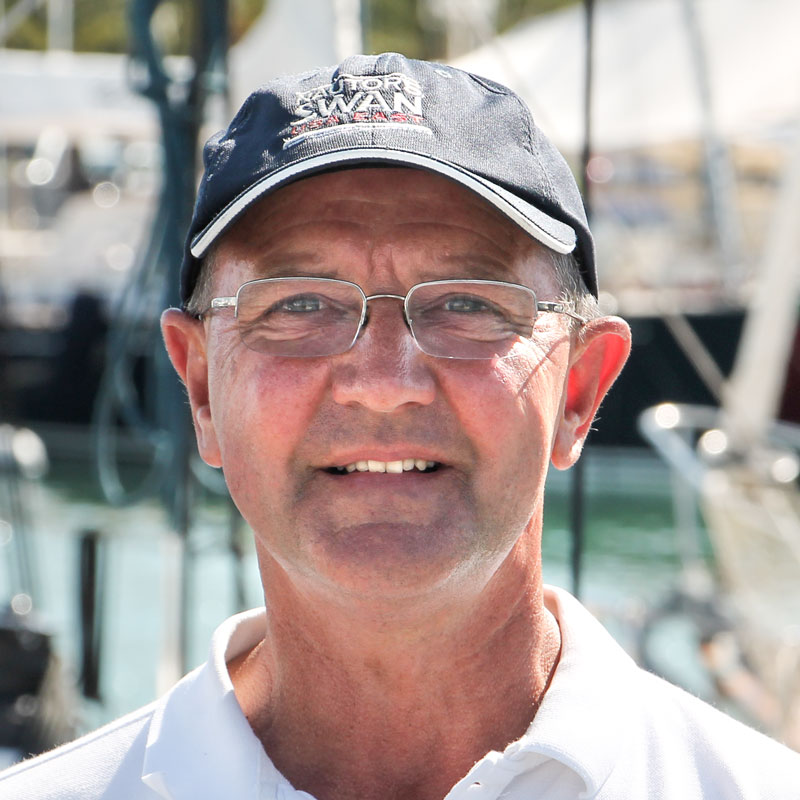
Current Listings:
We have many other Swan yachts available for purchase around the world. Below are some of our latest listings, or click here to view all current listings.

